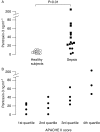Regulation of pentraxin-3 by antioxidants
- PMID: 19864306
- PMCID: PMC2777941
- DOI: 10.1093/bja/aep298
Regulation of pentraxin-3 by antioxidants
Abstract
Background: Pentraxin-3 (PTX3) may be a useful biomarker in sepsis, but its regulatory mechanisms are still unclear. Oxidative stress is well defined in patients with sepsis and has a role in regulation of inflammatory pathways which may include PTX3. We undertook an in vitro study of the effect of antioxidants on regulation of PTX3 in endothelial cells combined with a prospective observational pilot study of PTX3 in relation to markers of antioxidant capacity and oxidative stress in patients with sepsis.
Methods: Human endothelial cells were cultured with lipopolysaccharide 2 microg ml(-1), peptidoglycan G 20 microg ml(-1), tumour necrosis factor (TNF) alpha 10 ng ml(-1), interleukin-1 (IL-1) beta 20 ng ml(-1), or killed Candida albicans yeast cells plus either N-acetylcysteine (NAC) 25 mM, trolox 100 mM, or idebenone 1 microM. Plasma samples were obtained from 15 patients with sepsis and 11 healthy volunteers.
Results: PTX3 levels in plasma were higher in patients with sepsis than in healthy people [26 (1-202) ng ml(-1) compared with 6 (1-12) ng ml(-1), P=0.01]. Antioxidant capacity was lower in patients with sepsis than healthy controls [0.99 (0.1-1.7) mM compared with 2.2 (1.3-3.3) mM, P=0.01]. In patients with sepsis, lipid hydroperoxide levels were 3.32 (0.3-10.6) nM and undetectable in controls. We found no relationship between PTX3 and antioxidant capacity or lipid hydroperoxides. Cell expression of PTX3 increased with all inflammatory stimulants but was highest in cells treated with TNFalpha plus IL-1beta. PTX3 concentrations were lower in cells co-treated with antioxidants (all P<0.05), associated with lower nuclear factor kappaB expression for NAC and trolox (P<0.05).
Conclusions: PTX3 expression is down-regulated in vitro by antioxidants. Plasma levels of PTX3 are elevated in sepsis but seem to be unrelated to markers of oxidant stress or antioxidant capacity.
Figures




References
-
- Mantovani A, Garlanda C, Doni A, Bottazzi B. Pentraxins in innate immunity: from C-reactive protein to the long pentraxin PTX3. J Clin Immunol. 2008;28:1–13. - PubMed
-
- Bottazzi B, Bastone A, Doni A, et al. The long pentraxin PTX3 as a link among innate immunity, inflammation, and female fertility. J Leukoc Biol. 2006;79:909–12. - PubMed
-
- Breviario F, d'Aniello EM, Golay J, et al. Interleukin-1-inducible genes in endothelial cells. Cloning of a new gene related to C-reactive protein and serum amyloid P component. J Biol Chem. 1992;267:22190–7. - PubMed
-
- Lee GW, Lee TH, Vilcek J. TSG-14, a tumor necrosis factor- and IL-1-inducible protein, is a novel member of the pentraxin family of acute phase proteins. J Immunol. 1993;150:1804–12. - PubMed
-
- Vidal Alles V, Bottazzi B, Peri G, Golay J, Introna M, Mantovani A. Inducible expression of PTX3, a new member of the pentraxin family, in human mononuclear phagocytes. Blood. 1994;84:3483–93. - PubMed
Publication types
MeSH terms
Substances
Grants and funding
LinkOut - more resources
Full Text Sources
Medical
Miscellaneous

